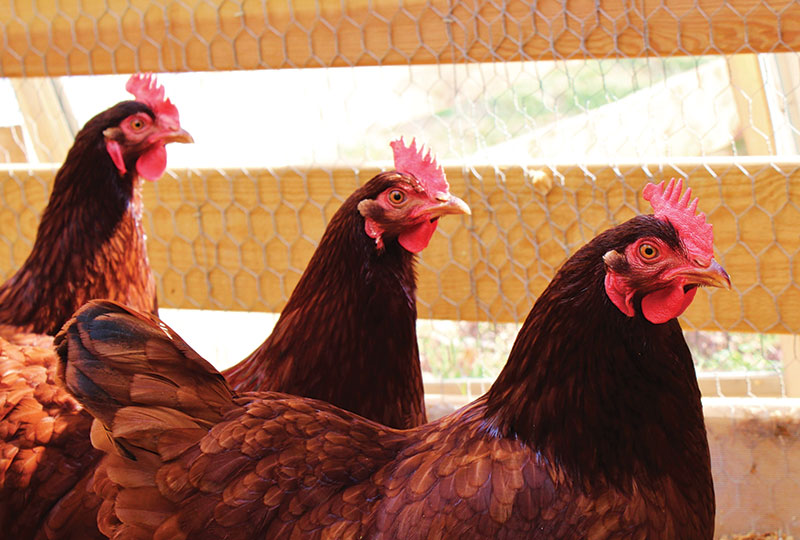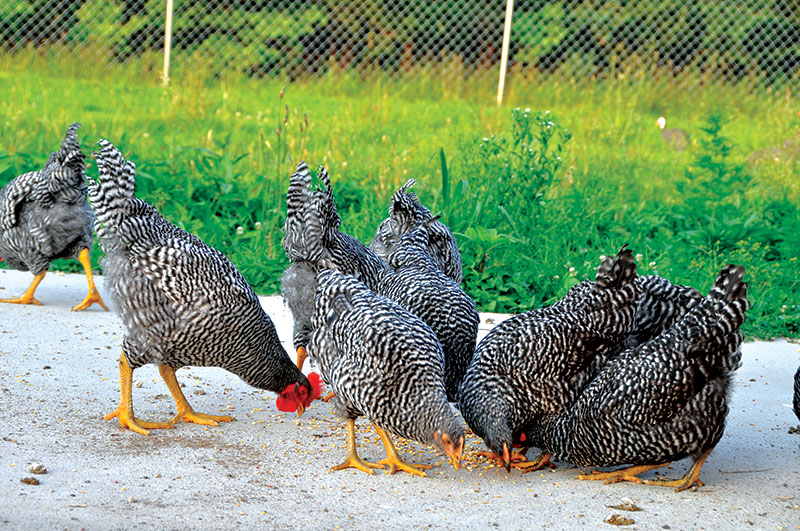
A heritage chicken is a traditional breed developed through many years of selection and passed down through generations. The exact definition varies with who’s talking. The Society for the Preservation of Poultry Antiquities defines a heritage breed as being old and rare, and defines “old” as existing before 1940.
A more specific definition for heritage chickens comes from The Livestock Conservancy, which offers and suggests that such terms as heirloom, antique, old-fashioned and old-timey should be considered synonymous with heritage.
According to this definition, a heritage breed must:
- have been recognized by the American Poultry Association before 1950;
- reproduce through natural mating;
- have the genetic ability to live a long and vigorous life;
- thrive outdoors under pasture-based management;
- and have a moderate to slow growth rate
Compared to chickens developed for industrial purposes, heritage chickens generally have calmer dispositions, are more disease-resistant, are better able to adapt to variable climates and environments, and are more likely to brood (hatch their own eggs). The trade-off is that the heritage laying-breeds don’t lay quite as well, and the meat breeds don’t grow as fast, as industrial strength chickens.
In selecting heritage chickens for your own flock, consider first your purpose in keeping chickens. If your goal is to harvest lots of eggs, choose a breed known to lay well. If your goal is to produce healthful meat, select a heavy breed. For the best of both, choose a dual-purpose breed. If your desire is to have pretty chickens gracing your yard, take a look at some of the ornamental or exhibition breeds. Here are just a few of the many possibilities.
Great Egg Layers
The top layer by far is the Leghorn, the breed selected by the egg industry to develop into laying machines. Production White Leghorn hens lay more than 25 dozen medium to large white-shell eggs per year. Heritage Leghorns, on the other hand, average just 20 dozen eggs per year, but the hens come in several plumage colors that are less conspicuous to predators than pure white. This small-bodied breed has a reputation for being noisy and nervous, but is also early maturing, hardy and heat-tolerant.
The most popular brown-egg heritage breed is the Rhode Island Red (pictured below), averaging about 16 dozen large eggs per year. As with Leghorns, some strains of Rhode Island Red have been developed purely for production purposes. This breed comes in one color pattern—dark red with a black tail. Rhode Island Reds, like layer breeds in general, tend to be lightweight and rangy, and therefore less suitable than heavier breeds to raise for meat.
Best for Meat
The large breasted Cornish chicken, with its compact body, is an ideal meat bird. The white Cornish is in fact, one of the breeds selected by industry to hybridize for efficient meat production. Heritage Cornish don’t grow as fast as industrial strains—taking 16 to 20 weeks to reach market weight, compared to 6 to 8 weeks for industrial Cornish hybrids—but they don’t develop the same bone ailments and heart failure resulting from excessively rapid growth. Additionally, heritage strains come in plumage colors other than white.
Cornish chickens are unusual in that hens are identical in conformation to males, although somewhat smaller; market weights for heritage hens are 61⁄2 pounds compared to 81⁄2 for roosters. Cornish hens average only about six dozen eggs a year, making them uneconomical as layers. Other large heritage breeds suitable for meat production, that lay somewhat better than Cor–nish, include Cochins and Jersey Giants.
Dual-Purpose Breeds
Dual-purpose breeds appeal to people interested in sustainability—keeping hens for eggs and roosters for fertility, hatching future replacement hens, and butchering young surplus roosters for meat. Dual-purpose breeds lack the blocky body of meat breeds, and they don’t lay quite as well as the layer breeds. Expect only about 15 dozen eggs per year from a dual-purpose hen.
The New Hampshire is a dual-purpose breed created through selective breeding of Rhode Island Reds to improve growth rate and meatiness. Like Rhode Island Reds, New Hamps come in a single color—a light reddish bay, more golden than the Rhode Island’s rich mahogany. The hens lay large eggs with brown shells.
The Plymouth Rock (pictured below) is another large, meaty dual-purpose breed. It comes in a few color varieties, the original and still most popular of which is black and white barred. The hens lay large brown-shell eggs. Other dual-purpose breeds to consider include Orpington and Sussex.
Awesome Ornamentals
Not all heritage breeds are ideal for egg or meat production. Some are bantams, or scaled-down chickens, that make a good choice for people with limited chicken-keeping space. Bantams lay eggs, just like the bigger chickens, and although the eggs are small they may be used for all the same purposes. Raising bantams (other than bantam Cornish) for meat would be akin to raising pigeons—small, but tasty.
Silkies, with their furlike feathers, are by far the most popular heritage bantam breed. They come in a several color varieties, most commonly black or white. They are friendly, docile chickens that don’t fly well. (Some won’t even perch.) The hens are decent layers of ivory-colored eggs and are such excellent setters they are often kept solely for incubating the eggs of other poultry.
One of the most important reasons to keep a heritage breed is to help preserve genetic diversity. The Livestock Conservancy lists heritage breeds according to conservation priorities. Review the many options and select one that most appeals to you. When it comes to heritage chickens, you can’t go far wrong.
This story originally appeared in the September/October 2018 issue of Hobby Farms magazine.




